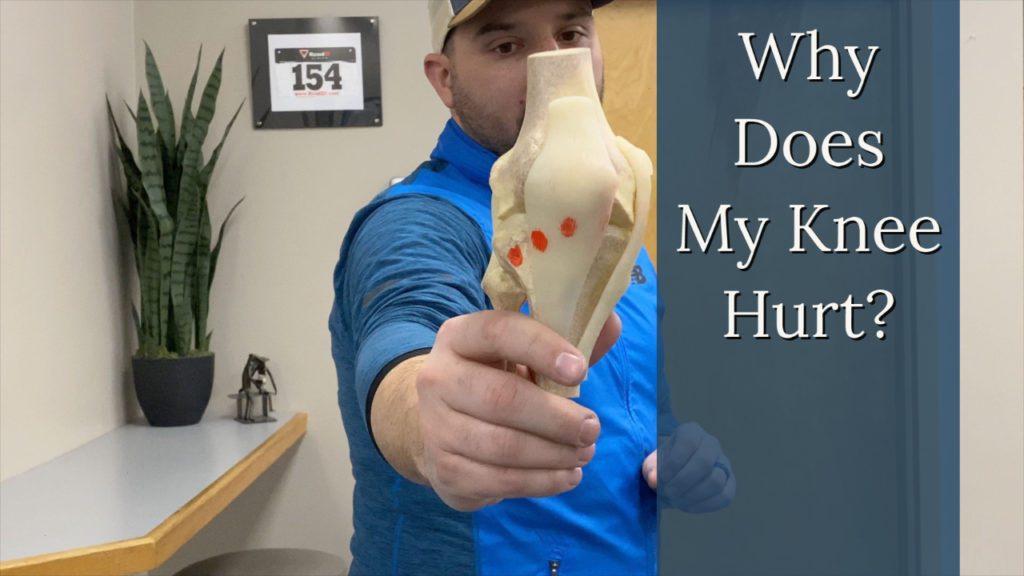Knee Pain in Runners: The What and Why
Raise your hand if you’ve ever experienced knee pain. Wow, there’s a lot of you in the crowd tonight. To be honest I’m not surprised to see so many hands in the air. Knee pain is one of the most common complaints from runners. I would love to quote some statistics but the numbers are all over the place. Studies show the incidence of knee pain all over the map from 30-79% for runners. So to keep things neat, I’m going to leave it at this: Knee pain sucks, and you will experience it at some point.
Knee pain, AKA runner’s knee, AKA patellofemoral pain, AKA jumper’s knee, aka crepitus, AKA tendinopathy, AKA tendonitis, AKA ITB syndrome, is a hell of a thing for runners. It is a very nondescript term that doesn’t give us much information at all. Other than the location of the pain, which we already knew as soon as you point to where the boo boo is. So what can we take away from this ailment that plagues runners mile to mile? A lot actually.
At the sake of being quite reductionist, I’m going to limit this post to the three most common areas of knee pain. That is, the three most common areas we see runners report discomfort. This is by no means an exclusive list. There are plenty of others to add to the differential diagnosis list, but these three will get us started.
The knee cap, or patella, is our reference point for the knee. The majority of runners with non-traumatic knee pain will report this pain below the knee cap. The piece of tissue located there is called the “patellar tendon.” Its job is to transfer force from the quadriceps muscle to the shin bone. Since this is a repetitive motion during running, it is often a site of issue. When the demands of the muscle exceed the capacity of the tendon, it gets cranky and lets us know. Voila…”Runner’s Knee!”
From our findings, the pain can be below the kneecap in the center of the tendon, below and to the outside of the tendon, or below it and on the side of the shin bone. These three locations tell us more than meets the eye.
If the pain is centered below the knee cap and on the patellar tendon, we tend to classify this as “Jumper’s Knee.” This is a condition seen in sprinters and jumpers. Think of track and field athletes or short-distance sprinters. These activities need a lot of deep knee bends and this increases compressive forces at the knee. The end result is often a pain directly below the knee cap.
Steady-state runners or endurance athletes tend to have their knee pain off to the side a bit. “Classic” patellar tendonopathy is a condition of the tendon marked by off-center pain. Let’s leave the reasons aside for the time being and instead note the uniqueness. This knee pain is off to the outside below the knee cap and differs markedly from Jumper’s Knee. Excessive or sudden downhill running, increase in intensity, or increase in volume is often the culprit. It is not likely to be a “lack of stretching or warming up” as is often reported. Those pitfalls mentioned above increase the demand for the tendon without proper acclimation. Ultimately the tendon breaks down.
Pain located on the bone or off to the outside of the patellar tendon is often the “IT Band” acting up. This is also a tendon, but one running down the outside of the thigh, attaching to the front of the knee. As a tendon, it also falls subject to proper capacity demands. Dreaded ITB issues can be a boogeyman for a lot of runners but only because it is mistreated. Runners with weak hips or a narrow running gait will often find themselves subject to ITB issues. Individuals who run on the track or sloped uneven ground may also fall victim to this diagnosis. This is because the hips play a crucial role in stabilizing the knee. Hip weakness or terrain issues may lead to a breakdown at the knee on the outside. And thus ITB issues are born.
Conventional wisdom has been to stretch it away and massage the crap out of it. The problem is, tendon issues arise from excessive forces and compression to begin with. This is due to excessive demand from running style or weakness. More compression from stretching or manual work won’t cut it for tendons. People often find themselves frustrated and spinning their wheels without improving. This is why tendon issues become the bubonic plague for many runners.
Let’s ditch the conventional wisdom and start with a better understanding of the “what” and the “why.” Only then can we move on to the “how” as in “how to fix it.”
Stay tuned for more on “Knee Pain in Runners” and how we get to the “how.”
Happy Training!
